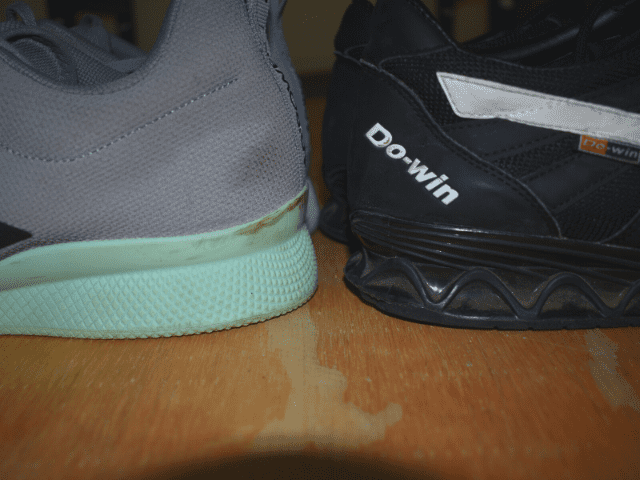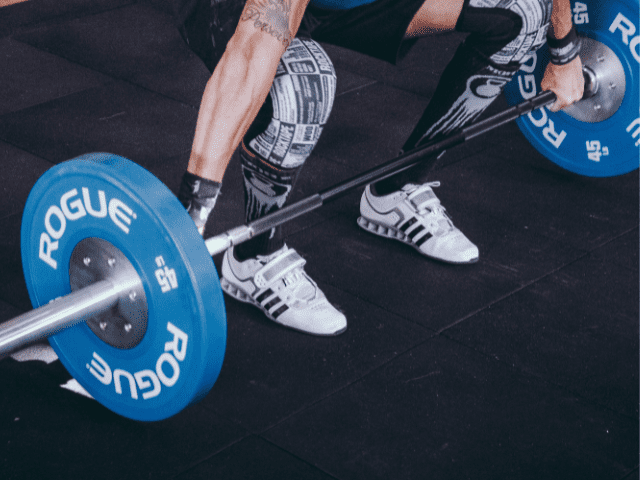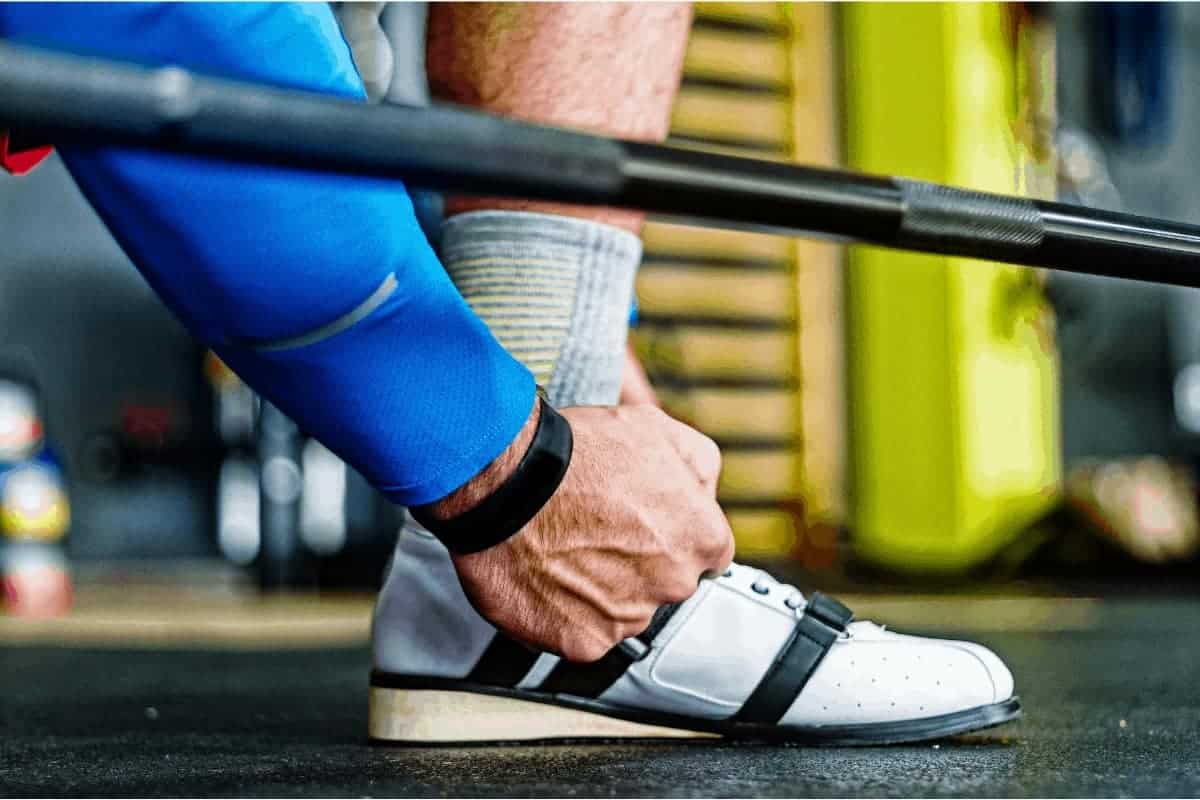Why Wear Weightlifting Shoes (3 Reasons)
At some point in all our lifting careers, we reach a point where we notice someone else in the gym wearing weightlifting shoes. Typically, this person is pretty skilled in their lifts and usually pretty strong to boot.
At this moment we are confronted with two questions: what exactly do those shoes do and more importantly – why wear weightlifting shoes?
Weightlifting shoes are worn for three main reasons. An elevated heel can help achieve better body angles, especially for squatting movements. The extremely dense sole minimizes force absorption allowing for more power to be transferred to the ground and the wider base creates more stability.
So, should you be wearing lifting shoes? First, let’s break down each of the three aspects of weightlifting shoes, and then ultimately you’ll be able to decide whether or not you need a pair for yourself.
Why Wear Weightlifting Shoes?
Elevated Heel

Weightlifting shoes are designed with an elevated heel, typically about 0.75″. This is double the heel drop on a typical athletic shoe. This elevated heel lessens the necessary ankle mobility to achieve a full squat position. By elevating the heel, it allows the knees to track forward a bit more naturally. This then allows the hips to drop lower while maintaining a more upright torso.
The argument against an elevated heel is that it leads to less mobility and makes the lifter too dependent upon the shoe. This is just not the case. Should you still work on your ankle mobility? Absolutely.
But, wearing a lifting shoe is not going to negatively impact your range of motion.
Quick note though, for anyone who is a complete beginner to lifting shoes (and maybe lifting in general).
There are a few exercises that an elevated heel is a detriment, not an advantage. The most obvious of these is the deadlift. You want to be as low to the ground as possible for deadlifts. Most serious lifters will deadlift in a pair of Chuck Taylors or even barefoot.
Transfer of Force

Here is my favorite analogy to explain the transfer of force. I use it with my athletes when explaining to them why a strong core is important for lifting and athletics in general.
Your eternal foe has two different baseball bats. One is a Nerf Bat. (If you’re young and don’t know what a Nerf Bat is, google it) The other is a wooden bat. They are going to swing each bat with the same amount of force. Which bat do you NOT want to get hit with?
The answer is easy. The wooden bat. Why? Because the wooden bat is dense and almost all of the force generated by your enemy is going to transfer through the bat and ultimately – to you.
On the other hand, the Nerf Bat is soft and pliable. The majority of the force generated by your enemy is going to dissipate as it travels down the bat. By the time the bat makes contact with you, much of the original force has been lost.
In this analogy, lifting shoes are the wooden bat. Weightlifting shoes are made with super dense materials in the sole. Typically a specialized hard plastic, foam or wood. This allows force to be transferred from your foot to the floor without absorbing any of the force in the shoe itself.
Athletic shoes are the Nerf Bat. Athletic shoes are specifically designed to absorb force. Being able to effectively absorb force is what helps to protect your feet and joints from running, jumping and any other kind of athletic activity. However, if all you want to do is squat or clean, then it’s not an advantageous design.
Wide, Hard Base Creates More Stability
When catching Olympic lifts, stability is paramount. When you’re trying to catch 308lbs in a front squat position, you don’t want to lose balance because you’ve worn out the outer edge of your training shoe.
You want to be as stable and balanced as possible every single time. In fact, this should be a given to the point where “not being stable” even crosses your mind.
Lifting shoes provide the base you want – consistently. The heel of the shoe, whether made of wood or the newer hard plastics is not going to wear out or become uneven. I have an old pair of Adidas Adistars that after twenty years, the material of the shoe literally disintegrated. The wood bottom heel, though? Unchanged.
A stable base is not just great for Olympic Lifts. Any squatting movements and even single leg movements like step-ups and lunges feel better in lifting shoes.
The Reason Most People Don’t Wear Lifting Shoes

The most obvious reasons people don’t wear lifting shoes are they either, A, don’t do Olympic lifts (or heavy squats for that matter) or, B, they just aren’t that into lifting.
That’s not what I’m talking about.
If you are that into lifting and you haven’t picked up a pair of lifting shoes yet, the main reason is usually the price. Most lifting shoes cost anywhere from $150-$200 dollars (although there are some lower cost options like Do-Wins that are around $100).
That’s a big commitment for something you’ve never tried and are not even sure you’ll really like.
Here’s what I can tell you. A good pair of lifting shoes, Romaleos, Adipowers, Do-Wins, etc will last you a really long time. My Adistars would have been legal to drive before they fell apart. I have a pair of Do-Wins that are 3 years old and still look great. So, while they’re not cheap, they’re also going to last you longer than any other shoe you own.
As for whether or not you’ll like them? You’ll love them.
Seriously, it’s extremely rare that any of my athletes over the years have tried lifting shoes and not been immediately hooked on them. The only question you’ll ask yourself is, ‘Why didn’t I get these sooner?!?’.
Final Thoughts
My assumption is if you’re reading this then you’re currently on the fence about grabbing your own pair of lifting shoes. My suggestion is if you’re thinking about getting a pair – get a pair.
After you get your new pair and your buddy asks you, “Why are you wearing weightlifting shoes?”. You can tell them –
Lifting shoes are great for all your Olympic and squatting movements. The elevated heel makes deep squatting positions easier to achieve and maintain. The denseness of the heel provides the ability to transfer more force into the ground meaning more powerful squats and pulls for you. Finally, the wider, more stable base makes your catches more balanced and consistent.
I don’t know if I’ve ever talked to a person who regretted getting their own pair of lifting shoes. I don’t think you’ll be any different.
Stay Strong!

